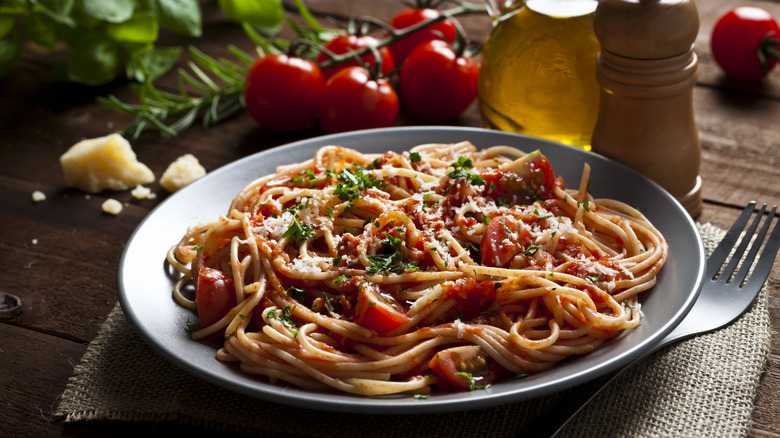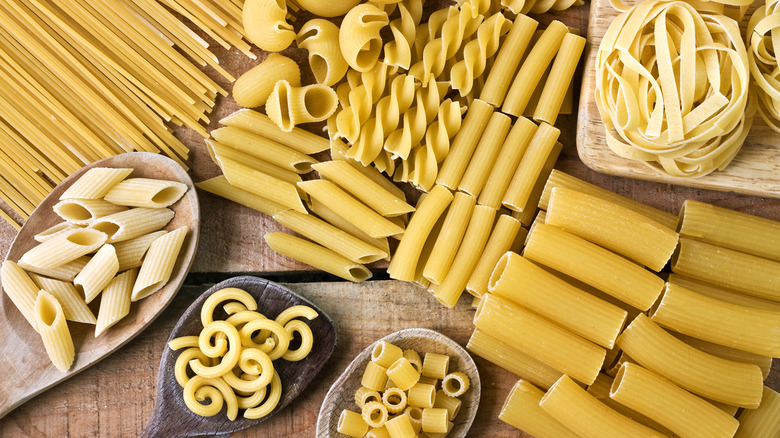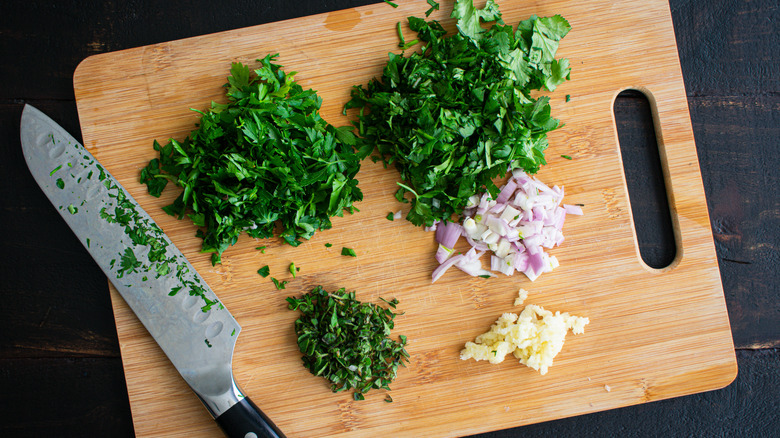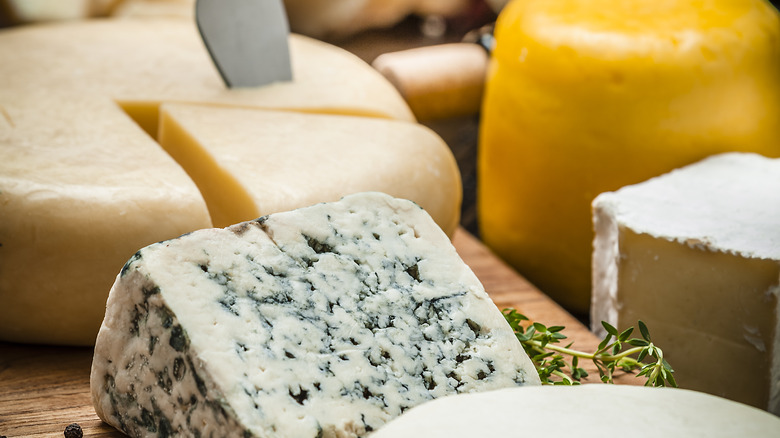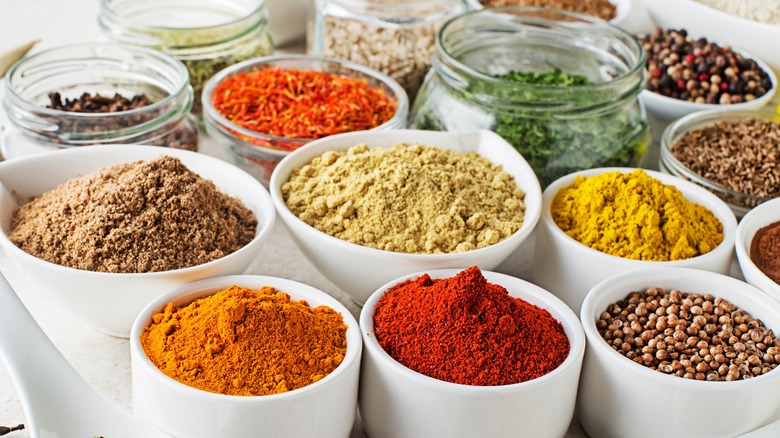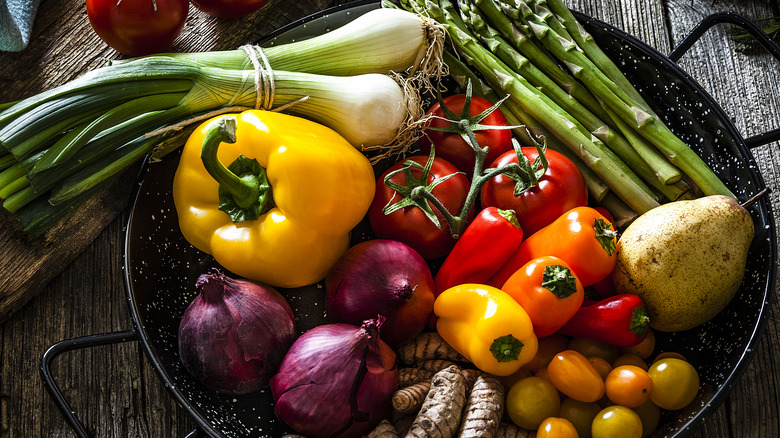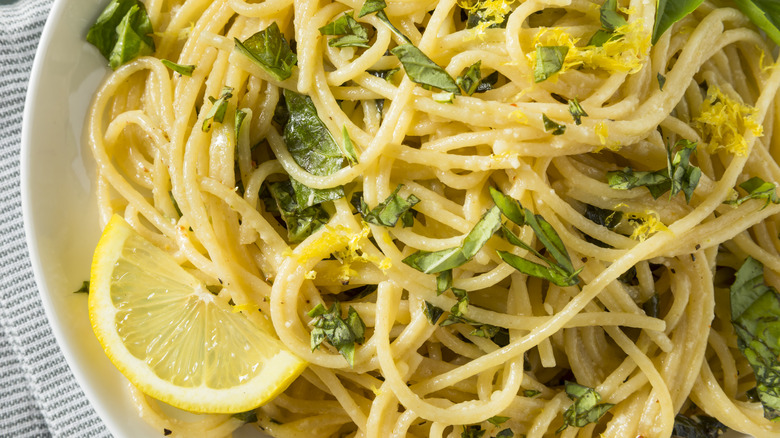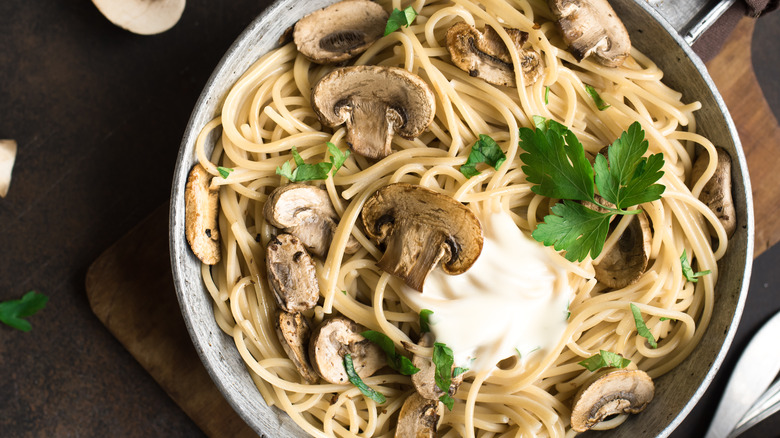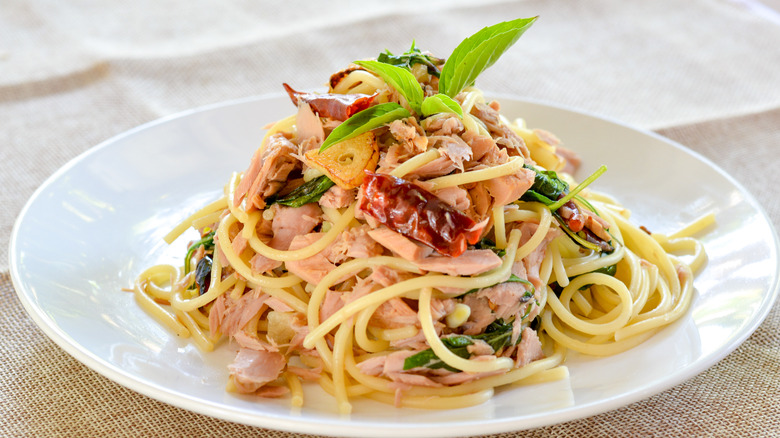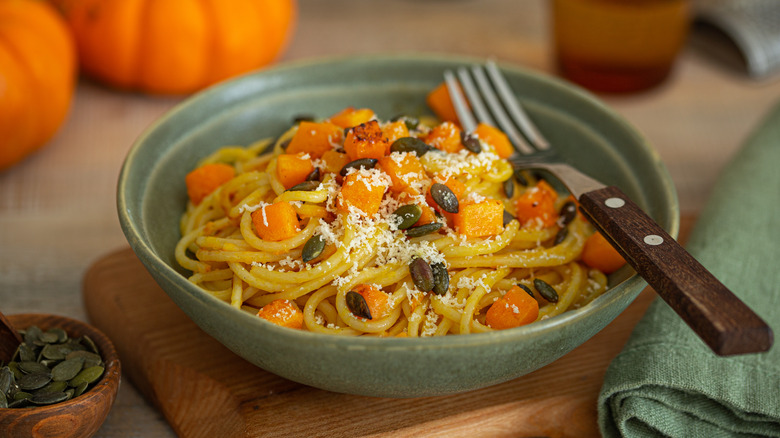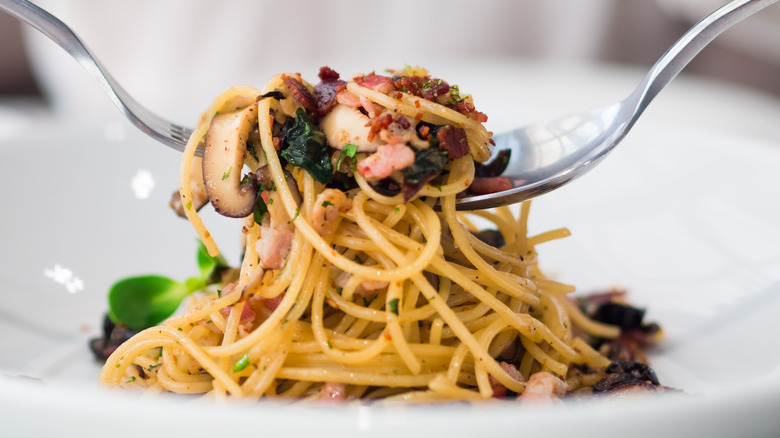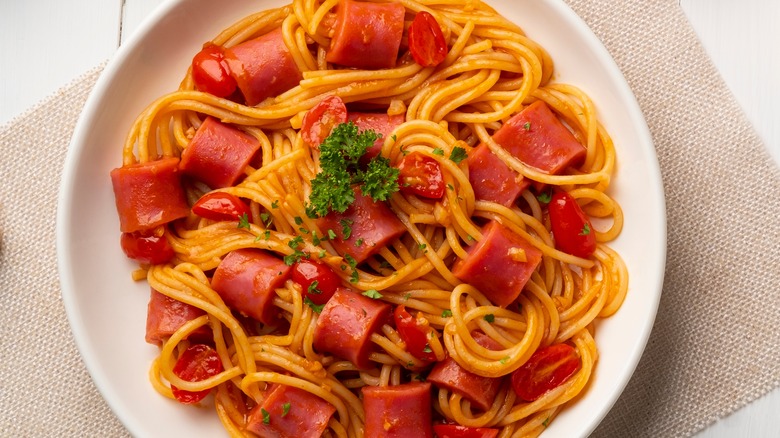The Best Ways To Liven Up Plain Spaghetti
Besides being incredibly tasty and a family-favorite comfort food, spaghetti is affordable, hearty, and easy to prepare. It's a perfect option on weeknights, or anytime you need a filling meal in a hurry. And anyone can make it, regardless of your talent in the kitchen. Just boil as little or as much pasta as you need. Brown some ground beef until tender and juicy. If you're feeling fancy, throw some garlic and onions in as your meat sears. Then, add your sauce, spices, and cooked pasta, mixing everything together to make the ultimate one-pot meal. It's super easy but also super delicious!
Even better: The great thing about spaghetti is that as easy as it is to prepare, and as good as it already tastes, it's also one of those dishes that you can continually improve upon. That's right — there are countless ways to liven up any pot of spaghetti, from how you cook it, to the ingredients you include, and even how you serve it. Here's a handful of our favorite spaghetti upgrades: These tiny tweaks, easy additions, and simple substitutions all yield seriously impressive results. Try one or try them all, and make that ordinary plate of pasta into a world-class entrée!
Try different styles of pasta
This first tip might draw the ire of traditional Italians and seasoned chefs. But hear me out. For many Americans, spaghetti is more than a type of noodle. It's the name we give the classic dish that's made up of pasta, sauce (with or without meat), herbs, and cheese. If you're eating low-carb and swap your pasta for zucchini noodles, you still say you're eating spaghetti. Same thing if you make the dish with spaghetti squash in place of noodles, or even eggplant slices as your pasta substitute. The dish is still "spaghetti." So why does your spaghetti have to include traditional long, skinny spaghetti noodles?
Liven up your dish and try a different shape. Make your "spaghetti" with penne, ziti, or elbow macaroni. You can also use fresh pasta in place of dried. Or, try a pasta made from a different base grain, instead of traditional semolina. Maybe a whole wheat pasta, or a quinoa, bean-based, or even brown rice pasta. Stores are overflowing with different varieties and options you can pick from.
The bottom line: Don't limit yourself or pigeonhole what ingredients you can use to make your "spaghetti." Try all sorts of different pastas in different shapes, and made from different ingredients. Sure, you may not technically be cooking "spaghetti" anymore, but if your meal is delicious, your tastebuds (and your family) certainly won't care.
Toast your pasta before you cook it
You may have tried toasting spices in the past. This simple process brings out their richness and makes dishes even more flavorful. Simply add your spice of choice to a warm, dry skillet and let it toast for a minute or two before you use it. You can also toast nuts and seeds, dry grains like oats or quinoa, or even coconut or breadcrumbs in much the same way, heating them gently for a minute or two before using them in any recipe. In all cases, that exposure to the heat of a warm, dry skillet helps to release essential oils in the food you're toasting and makes it even more vibrant and flavorful.
You can also do the same thing with any pasta you use to make spaghetti. Toasting will give your pasta a much richer, more intense, nutty flavor. It's delicious!
Just place the pasta in a dry, warm skillet (or a skillet with a very small amount of oil) and let it "toast" for a minute or so per side. Stir the pasta often — you don't want it to burn. Toast in batches if necessary — don't fill your skillet too full. Alternately, if space is an issue, spread your pasta on a baking sheet and toast it in a 350-degree Fahrenheit oven for five to 10 minutes, or until it is noticeably deeper or browner in color. Then, boil and prepare the toasted pasta like normal.
Add fresh herbs to your spaghetti
Once you've landed on a style of pasta you want to make your spaghetti with, the absolute best way to continue livening up that dish is by adding all sorts of fresh herbs to your pot. Compared to dried spices that may have been sitting in your spice rack for who knows how long, fresh herbs have a much brighter, more potent, and more complex flavor profile. They're also packed with rich aromas that further stimulate our senses and make any dish more appetizing and incredible.
Traditional spaghetti favorites include sweet basil, peppery parsley, and oregano, which gives spaghetti a robust, earthy quality. But don't stop there. As you're selecting which fresh herbs to feature in your spaghetti, also consider thyme (which contains hints of lemon and mint flavors), rosemary (which is floral and a bit piney), and even tangy dill.
Beyond those classics, bittersweet tarragon, spicy lemongrass, licorice-like fennel, and even mild and sweet marjoram are all excellent potential spaghetti additions. Just dice 2 to 3 tablespoons of your herb of choice (being careful to remove all stems). Then, add your herbs to your sauce in the final minutes of cooking, just before serving. This will allow the herbs to cook slightly and also help to preserve their freshness and vibrant colors.
Experiment with flavored oils
Like fresh herbs, flavored cooking oils and finishing oils are another extraordinary way to liven up any pot of "ordinary" spaghetti. For those who are new to how these oils are used, you don't cook with them. Flavored oils are not for frying or sautéing or anything of that nature. Instead, these oils are used a lot like a sauce or garnish and are drizzled over your food immediately before it is served to add an extra kick of flavor and refinement.
Garlic-infused oil is one ideal option to pair with any plate of spaghetti. It enhances the flavor of any garlic you already have in your dish and really helps to make that garlic bite pop when you dig into your pasta and sauce. Chile-infused oils are another good option to add fire and heat to spaghetti. You might also use a zesty lemon-infused oil, an herb-infused oil (basil and rosemary are common flavor options), truffle oil, or even a sun-dried tomato oil.
Drizzle a small amount of the oil of your choice over your food and give it a taste. Then, add more if needed. Flavored oils can be intense, so you don't want to use too much and overpower your spaghetti — start small and then add more oil if needed.
Try different varieties of cheese
Certain cheeses are as common with spaghetti as strawberry or grape jam are with the peanut butter in your PB&J. They're a given. But that doesn't mean you need to use them in the dish! Sure, countless Italian recipes are built around cheeses like Parmesan, mozzarella, and Pecorino romano. And these salty, nutty cheeses really are delicious, so the pairing makes sense. But if you want to liven up your spaghetti, one of the easiest tweaks you can make to your recipe is simply featuring a different cheese in the dish.
Take ricotta: This creamy, mild cheese lends a fabulous richness and velvety texture to spaghetti dishes. It's a perfect substitute for "traditional" cheeses and can be either mixed into spaghetti sauce or dolloped on the side of your plate to add a luxurious touch to any meal. Fontina is another excellent cheese to consider adding to any pot of spaghetti. This smooth, buttery cheese goes especially well with dishes containing mushrooms or spinach, helping the earthy and umami-rich qualities of each ingredient to shine brightly in your spaghetti.
Tangy goat cheese, pungent gorgonzola, and crumbly, salty Feta cheese are also all amazing potential additions to any spaghetti recipe. You might also consider asiago cheese, which adds a unique, slightly sweet quality to spaghetti. Finally, burrata is one more ideal choice. It melts beautifully and is the perfect complement to fresh tomatoes, basil, and olive oil, all of which are key components in almost any version of spaghetti you might dream up.
Sample alternate spices
Part of the charm and classic "comfort food" quality of Italian food is that we always have a reasonably good idea of what a dish will taste like. There will likely be some combination of onion and garlic plus basil, oregano, parsley, and maybe red pepper flakes. That flavor profile is what sets Italian cuisine apart from other types of food, and is a vital part of what makes it so special and unique. But, at the same time, these widely used flavors can also sometimes make spaghetti or other Italian dishes seem dull or flat. There's no surprise — nothing unexpected to shock our taste buds and wake them back up to what they are eating.
The solution? Just use some different spices! There's no rule that your spaghetti needs to be built around the same Italian flavors as every other plate of spaghetti in the world. Mix things up, try new combinations, experiment, and see what exciting new spaghetti flavors you can create!
For starters, maybe throw some cumin in your pot to amp up your spaghetti's earthy, citrus flavor. Or, sprinkle in some coriander to give your spaghetti a wonderful brightness and sweet, acidic punch. You could also add turmeric, which has a warm, peppery flavor with slightly bitter undertones. Or smoked paprika, which brings a mild pepper bite and loads of intense, wonderful smoky flavor. Fennel seeds (which taste like licorice), cardamom, sumac, cinnamon, and nutmeg are also good potential alternate spices for any DIY pot of spaghetti you might whip up.
Add seasonal produce
Tomatoes — both canned and fresh — are an integral part of any plate of spaghetti. But to truly elevate your dish, don't be afraid to fill it with fresh, in-season veggies as well. In the spring, chunks of tender asparagus pair beautifully with spaghetti, imparting their sweet, delicate flavor. Crisp peas and earthy spinach are also good options.
In the summer, you can't go wrong with adding slices of zucchini or diced bell peppers to spaghetti. Both add incredible crispness, texture, and crunch to the dish and pair fantastically with meaty sauce and cheese. In the fall, make your spaghetti richer with the addition of chunks of roasted butternut squash. Bitter leafy kale is also ideal for hearty, robust spaghetti that's filled with garlic and chili flakes. Not to be outdone, seasonal winter produce like brussels sprouts, broccoli, and cauliflower also add nutrients, crunch, and texture to any pot of spaghetti.
In all cases, no matter what veggies you choose, it's generally best to cook them on their own — blanch or sauté them to tender perfection and then add them to the dish in the last few minutes before serving. This ensures they will be nicely cooked, but won't fall apart, which might happen if they are left to cook too long in a pot of simmering sauce.
Work citrus into your dish
Citrus zest — whether you get it from lemons, limes, oranges, or even grapefruit — is a fabulous addition to so many different foods. It can upgrade fried eggs. You can add it to brownies. And, when added to spaghetti, it provides a delicious burst of bright citrus flavor. Fragrant oils in the zest make your spaghetti's aroma even more delectable. Even better, the acids in the zest help to balance out spaghetti's rich and heavy sauce, making it seem lighter and more refreshing.
To add zest to any pot of spaghetti, simply grab a fine grater, microplane, or citrus zester and remove 1 to 2 tablespoons of the out layer of any citrus fruit's peel. Be careful to avoid the bitter white "pith" underneath. Then, add the zest to your spaghetti sauce towards the end of the cooking process, just before you plate up your spaghetti and dig in. This helps the zest to retain its fresh flavor and aroma without being cooked for too long, which can cause it to lose that punch.
Make it creamier
Prefer creaminess over zest and tang? No problem! You can also easily liven up any plate of spaghetti with all sorts of different tasty and decadent creamy additions to the dish. Starting with the creamiest of all ingredients — cream itself — try pouring 1 to 2 tablespoons of heavy cream or half-and-half directly into your spaghetti sauce towards the end of cooking. Just stir well and then let the sauce simmer a bit longer so that it will thicken slightly. For a more tropical-influenced plate of spaghetti, you can do the same thing with coconut milk. (It's a marvelous addition to seafood spaghetti or spaghetti that you've added curry spice or peanut butter to.)
You can also easily add a large dollop of cour cream, cream cheese, or plain unsweetened Greek yogurt to any pot of spaghetti. Pureed vegetables (like cauliflower, pumpkin, or butternut squash) and even a dab of butter will also enhance the creaminess of your dish in a pinch.
Add a touch of sweetness
Nobody wants a plate of meaty, cheesy spaghetti that's so sweet it tastes like a dessert. But, a touch of added sweetness can be a mouthwatering addition to dull spaghetti, adding depth and complexity to the dish and helping to balance out all those other savory and earthy flavors. Curious what a touch of sweetness might do to your next batch of pasta and sauce? Give it a try — there are many exceptionally delicious options.
For subtle sweetness, you can drizzle a bit of balsamic vinegar or even maple syrup into your sauce. Applesauce, honey, or a touch of brown sugar are great potential additions to the dish. Fruit can also be a wonderful and unexpected delight in spaghetti. Try adding some dried cranberries or raisins to your sauce or stir a touch of pureed dates or even a spoonful of apricot jam into your spaghetti for sweetness, plus a zesty tang.
Use an unexpected sauce
Just as it's possible to make "spaghetti" without traditional spaghetti noodles, your spaghetti also doesn't have to include a classic tomato-based sauce. Perhaps you've already ventured away from the norm and made spaghetti with Alfredo or vodka sauce. But those are just the tip of the iceberg when it comes to all the different and delightful sauces spaghetti can highlight. You can swap that tomato-based sauce for a classic pesto sauce, for example, and enjoy all the herbaceous flavor that the blend of basil, pine nuts, and Parmesan provides. Or, whip up a simple sauce made by sautéing garlic in olive oil — what the Italians call "Aglio e Olio."
Spaghetti is also an exceptional treat when topped with a deliciously light Carbonara sauce made from eggs, Parmesan cheese, pancetta or bacon, and black pepper. You might also swap in a Puttanesca sauce made from tomatoes, olives, capers, garlic, and anchovies — it's a bold and briny flavor sensation.
Finally, don't neglect simple vegetable-based sauces as well. You could elevate a standard plate of spaghetti considerably with a roasted red pepper sauce, a pumpkin-based sauce, a carrot and ginger sauce, or even a nut-based sauce like a walnut pesto. Mmmmm.
Make it smoky
Smoky flavors are an often underutilized part of cooking. We get them a lot during the summer, when food is fresh from the grill. But otherwise, that rich, woody, slightly charred flavor can be hard to replicate and is therefore often ignored. But it doesn't have to be! There are many ways you can bring the dark, complex, nostalgic flavor of smoke to your spaghetti, with just a few classic, carefully curated ingredients.
Smoked paprika is one great place to start. Made from smoked, dried peppers, it's a perfect way to impart a deep, smoky flavor to any standard plate of spaghetti. You could also add diced chipotle peppers in adobo sauce to your pasta. These peppers are smoked and dried and then packed in a tangy, smoky sauce, making them an ideal instant addition to any pot of spaghetti. Smoked meats and cheeses will also bring rich smoky flavor to spaghetti. Or, try stirring a few drops of liquid smoke or a tablespoon (or more) of Worcestershire sauce, molasses, bourbon, whiskey, or even brewed coffee into your sauce. Each will also impart its own incredible, deep, caramelized smoky essence into that plain plate of spaghetti.
Use unexpected meats
Finally, when it comes to fantastic ways to liven up any pot of spaghetti, don't forget that you aren't locked into using any specific protein. Sure, ground beef is the obvious go-to in most spaghetti recipes, but you can also mix things up and use any number of different proteins, both meat and plant-based.
Instead of beef, maybe you mix chunks of tender browned steak into your spaghetti? Or how about spaghetti with a decadent sauce that contains ground pork, ground veal, ground lamb, or even ground turkey? For a kid-friendly meal, your spaghetti might contain chunks of diced hot dogs. Or, you could make a more adult spaghetti with slices of pepperoni, sausage, or even chorizo. And don't forget seafood! You can also make marvelous spaghetti dishes containing clams, tuna, salmon, shrimp, and even anchovies and sardines.
And for the vegans or vegetarians in your life, mushrooms, lentils, chickpeas, tofu, tempeh, and even edamame can all be wonderful protein alternatives in plant-based spaghetti. Just prepare each protein individually so that it's fully cooked and ready to go. Then, stir it into your sauce just before you pour the sauce over the spaghetti noodles. This will help to protect the texture of these plant-based proteins and keep them from becoming too mushy or tough — issues that might occur if they are left sitting too long in a simmering sauce.

